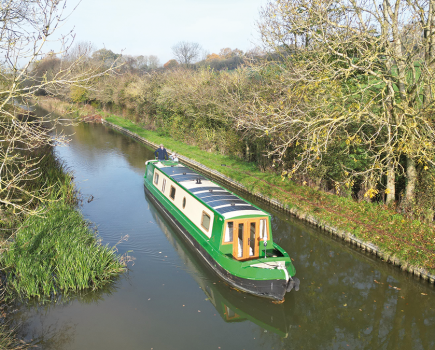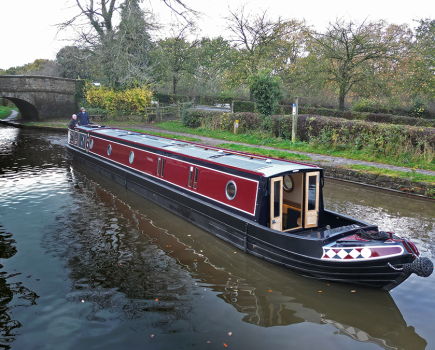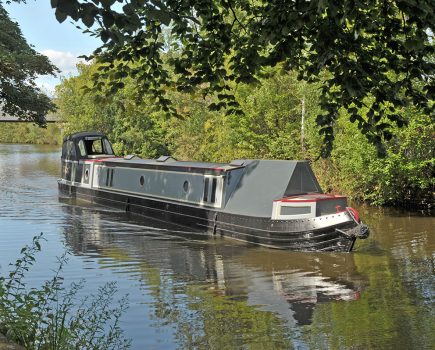A bespoke boat means you can really tailor your design to fit your dreams. And if that means an extended cabin and a gigantic bed, JD Narrowboats are happy to oblige

We regularly hear of people who see one of these boat tests and like the boat so much they order one just the same. That’s great, and it’s not surprising that some designs work for lots of people.
But the majority of boat builders we feature build bespoke boats – and most of them will tell you they’d get bored if they had to build the same thing over and over again. They like customers like Nigel and Jennie Eveleigh, who’d seen a boat in this magazine and at the Crick Boat Show, and liked it – but also wanted to adapt the design to suit their boating plans.
The boat they’d seen was by JD Narrowboats, which had an extended cabin rather than a well deck. They liked the fact that this arrangement gave a lot more inside space for the length of boat; and they loved the idea of a huge bed taking up the whole width of the front of the boat. However, they’ve done a lot of boating on the Thames, and know that it’s essential to have somewhere safe at the bow for a crew member to stand, so they can throw a rope over a bollard and hold on while the lock keeper fills or empties the lock.

One of the joys of using a bespoke boat builder is that they can do pretty much whatever you want. That’s perhaps even more true of a firm like JD Narrowboats who build their own shells as well as doing the fitting out. So they came up with a design that achieves two seemingly contradictory things: an extended cabin, and a well deck.
EXTERIOR

If you visit the JD Narrowboats yard on the Trent and Mersey Canal you’ll see boats in various stages of completion – from a pile of steel sheets, to virtually finished. And while they’ve built everything including boats with normal well decks and even tugs, it’s the ones with extended cabins that seem to have become a bit of a speciality. It’s a feature which is undoubtedly practical, offering a lot of extra interior space, without lengthening the boat as a whole. But it’s also almost certain to divide the crowd: some people will never want to sacrifice a seating area at the bow, while others won’t like the look of the boat.
In this case, Darron Howell, JD’s steel man, had to come up with a design which incorporated an extended cabin and somewhere safe to stand. The answer was a well deck – albeit a very short one. In fact, it’s just eighteen inches long, which is enough space to stand in, but not much else.
What’s surprising is how the presence of this little deck disguises the fact that the cabin comes much further forward than usual. Partly it’s because the cabin doesn’t have to curve in so much, so the forward bulkhead isn’t so narrow. And there’s another clever optical trick: rather than a big window at the front of the boat, this one has a set of glazed doors instead, making it look like most other narrowboats on the water. From a distance (and actually, even from fairly close) you’d think this boat had a full size well deck.

The steelwork looks good, and there are some nice touches such as scrolls in the cants and a finger grip along the handrails. The gas locker is in the nose, while a hatch in the little well deck gives access to the bow thruster tube. At the other end of the boat is a generously sized semi-cruiser deck, with storage lockers both sides, and arched steelwork semi-enclosing the area. At the very stern is a set of metal rails with hardwood tops.
The colour scheme uses black with cream coachlines and a cream roof. This dark colour also seems to disguise the fact that this is a relatively short boat, at just 54ft.
The windows are by Wesley Windows, and are double glazed.

LAYOUT AND FITOUT
This is a reverse layout boat – the whole point of the extended cabin was to achieve a great big bed in the forward cabin. Behind the cabin is a walk-through shower room. The saloon is in the middle of the boat, with the galley at the stern.

The fitout uses a combination of oak for the furniture and bulkheads, and painted ash-faced ply above the gunwales. It’s a modern feeling interior, and you can still see the grain of the wood under the paint.
GALLEY

Three steps take you down from the stern deck into the galley. The top two have lifting treads for storage, while the bottom one is a drawer. There are cupboards each side: one contains the electrics, the opposite one provides hanging space and has the calorifier underneath (making it a good place to dry damp coats).
The galley proper is dominated by beautiful oak worktops, made in house. They’re made from planks of oak, and even after being planed and sanded they’re a good 45mm think. On one side, the worktops opens out into a breakfast bar, giving a vast expanse of really lovely looking wood.
On one side of the boat there’s a Belfast sink, with a drainer routed into the worktop. As well as the normal hot and cold taps, there’s another for filtered water. On the opposite side there’s a Thetford slot-in oven. Other equipment includes a 12 volt Shoreline fridge, but it’s a bit wider than usual (and as such has to be specially ordered).

The owners wanted everything to look clean and smooth, so there are no protruding handles on any of the cupboards or drawers; instead, there are recesses in the doors. It means there’s nothing to catch you or your clothing as you pass through the galley. There is some great joinery on show, with a beautifully curved door at the end of the run of units. Behind, tucked under the gunwale, is a pull-out wine rack – complete with the outline of a bottle inlaid in a darker wood. There’s also a pull-out spice rack.
High level cupboards are limited to a couple of corner units at the stern. There’s also a simple high level mug shelf, which has an LED light underneath. A great deal of thought has been given to lighting in this boat. There are dimmable LEDs and lights under shelves and gunwales, as Nigel says they like to use lighting to create different moods on board.
There are side doors on each side of the boat, over the breakfast bar and opposite, both with glazed inner doors. That means you can let in light even when the weather isn’t so good. The breakfast bar itself has a couple of stylish stools. There’s also a radiator, which could be annoying for the person sitting on that side. The saloon-side of the unit also has a door giving access to what would otherwise be a dead corner.

SALOON
The major piece of furniture in the saloon is a big, comfortable, L-shaped sofa. It’s skilfully made with curved corners, and has storage in the base, with a large drawer. Normally, we’d be explaining how this converts into a guest bed – but in this case, it doesn’t: it’s been built to be as comfortable as possible for sitting on. Nigel and Jennie say their family tends to come and see them on the boat for the day, rather than overnight; in fact in ten years of boating, they’ve never had friends or family stay the night on board. They’re not as heartless as that might sound, though, because the sofa could be used as a single bed, and they also have a blow-up mattress just in case!

Opposite the sofa is an under-gunwale unit, which not only houses a flat screen tv but also a radio and CD player, built in speakers, and plenty of storage for CDs.
A free standing table is stowed under the gunwales, and there’s a high level shelf on the forward bulkhead, with lighting underneath.

SHOWER ROOM
The shower room is a walk-through design. The shower itself is very generously sized; it’s 900 x 900mm, but the bulbous shape of the cubicle means it’s more than a quadrant.
The loo is a Thetford cassette model, with a ceramic bowl. Access to the cassette is in a cupboard the other side of the bulkhead, and there’s room to store a spare.
In the corner opposite the shower is a decent sized corner unit holding a smart round basin. It has a cupboard underneath and drawers alongside. There’s a shaver point in the side and a mirror above. The room also has a heated towel rail.
One nice touch is that the shower room and the cabin beyond have wooden tongue and groove on the ceiling rather that the cream panels used in the public areas of the boat. It makes these more private spaces feel cosier.
CABIN
This is a really good sized cabin – with masses of storage and a huge bed. There are wardrobes both sides of the boat, forming a mini-corridor from the shower room. Again, all the cupboard doors and drawers have integrated handles. Next comes a chest of three big drawers. There’s more storage in the base of the bed, accessed by a couple of doors. Most of the bed base, though, is taken up with an 800 litre water tank.
The bed is where this design of boat really comes into its own, and one of the main reasons Nigel and Jennie wanted an extended cabin. It’s the full width of the boat, and as long as you like; so it’s six feet wide at the foot, and long too. Because the cabin curves inwards along the length of the bed, the mattress had to be specially made to fit. Each side of the bed has a cushion forming a mini headboard, a useful shelf for a glass of water, and a reading light.
In other boats with extending cabins, there’s normally just a window at the bow, meaning there’s no access to the front of the boat at all. But as Ripples has a mini well deck, there’s a set of half doors at the bow. They might not be everyone’s ideal way of getting out of the boat, but Jennie says climbing across the bed and going through them is an acceptable way of accessing the well deck when a lock is coming up. The alternative is walking down the gunwales.
TECHNICAL
This is a fairly straighforward boat technically. It’s powered by a Beta 38 engine, which should be powerful enough for a boat of this size. There is also a Vetus 55kgf bow thruster.
Electrical power comes from four 110Ah domestic batteries (and there’s also one for the engine and another for the bow thruster). A Victron 3kw multiplus inverter gives a 240 volt supply.
Heating is by an Eberspacher diesel boiler.
The engine is covered by a large deck board, but there’s a smaller board covering the stern-most part of the engine hole, making it easier to access the stern greaser and weed hatch.
ON THE WATER
Under way, this boat performs very well. The Beta engine is quiet and smooth, and the boat responds well to the tiller. It swims nicely, with little wash. During our test, Andy Darken from JD couldn’t remember whether the boat was fitted with an Axiom propeller. But when we needed to reverse a distance, he realised it does have one – because the boat completed the task in a pretty straight line.
The Morse control falls readily to hand, as it’s mounted on top of the stern rail. It’s a good idea, as many cruisers have the lever much too low. The instrument panel is clearly visible too.
The cruiser stern deck is large enough for plenty of crew, and the lockers give them somewhere to sit or put their cups and glasses. It’s also big enough to be a pleasant place to sit once moored up for the day.
CONCLUSION
Whenever we’ve tested boats with extended cabins, we’ve pointed out that they’ll never be everyone’s cup of tea. But there’s no doubting that the extra interior space can be very valuable. And, if like Nigel and Jennie you like a huge bed, it can be a way of accommodating it.
This boat avoids one of the compromises: the loss of the well deck. Admittedly the well deck in this boat is tiny and access isn’t the easiest, but it means there is somewhere safe to stand while holding a rope in a lock.
And it makes the boat look less unusual on the outside too. Inside, the fitout is simple but effective – and it’s always good to see a builder doing so much in house.
And the price is reasonable. You could have a boat like this for £100,000 – which represents good value.
So this boat succeeds on several levels: it’s squeezes maximum living space from a short total length; it looks good inside and out; and it meets the owners’ particular requirements. In that way, it also shows the value of going to a bespoke builder, who can built the boat you really want.
THE OWNERS
Jennie and Nigel Eveleigh have been boating for a while. They had a 41ft Sea Otter for around ten years, before swapping it for Ripples to give them a bit more space. Most of their boating has been on the Thames, hence their intimate knowledge of the need for crew and ropes when going through Thames locks.
Before that, they had a hire boat holiday on the Llangollen – and were immediately bitten by the boating bug. They say they knew straight away that they’d have to buy a boat of their own.
As they’re both now retired (Nigel was a chartered town planner and Jennie was a beauty therapist), they tend to go for long trips over the summer – usually of at least two months at a time. In the coming year they’re planning to explore new waters, heading north rather than south, for Yorkshire and the Pennines.
JD NARROWBOATS
JD Narrowboats consists of Darron Howell, who co-founded the business in 2003, and Andy Darken, who joined the firm about ten years ago, at about the same time as it moved to a canalside yard on the Trent and Mersey in Shardlow.
Darron is the firm’s fabricator – in fact, he designs the hulls as well as building them. He produces one a month, with many sold as sailaways to people who want to fit out their own boat. There’s a choice of trad, semi-trad, or cruiser, which can either have the eliptical stern seen here squarer design. The boats can be completed to any stage, depending on how much you want to do yourself.
Andy is in charge of the fitouts, of which JD completes about three a year, all of them bespoke. The firm employs a handful of staff to help with the work.
TECHNICAL SPECIFICATION
JD Narrowboats
Dobson Wharf, The Wharf, Shardlow, Derbyshire DE72 2GJ
01332 792271 www.jdnarrowboats.com
Length: 54ft
Beam: 6ft 10in
Shell: JD Narrowboats
Style: Semi-cruiser
Fit-out: Oak
Engine: Beta 38 Tel: 01452 723492 www.betamarine.co.uk
Inverter: Victron 3kw
Bow Thruster: Vetus 55kgf www.vetus.com
Fridge: Shoreline RR5511 £605.00 www.shoreline-marine.co.uk
Mattress: Foam Furnishings £prices vary www.foamfurnishings.co.uk
Total Price: £100,000
Image(s) provided by:
Archant







